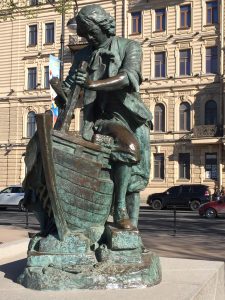97 Russian Domain: Political Geography – Russia’s Autocrats and V. V. Putin
The political history of the Russian people largely is subjugation under a series of autocrats. The chronology of strongmen/strongwomen leading the country with great power began with the reign of Ivan IV (Ivan the Terrible) in 1547. With singular figures such as Peter the Great and Catherine the Great, as well as bumps along the historical road of authority, Russian history brings us to the current autocrat Vladimir Vladimirovich Putin.
Of course, throughout the world and throughout history, peoples and lands have been ruled by powerful figures – tsars, kings, caesars, queens, princes, etc. At other times these autocrats have been elected figures, generally through fraudulent, coercive, or meaningless elections. It would seem that Russia has had at least its fair share of autocrats, perhaps more so that most countries.
To briefly review the topic of Russia’s tsars, let us make a few notes, before moving to post-tsarist autocrats. Also, let’s comment a bit on how power is held by these rulers.
Ivan the Terrible was the first Russian ruler to take the title “Tsar.” His moniker “Terrible” uses the Russian word грозный; however, the word may be translated as “formidable” or “fearsome” as well as “terrible.” In the case of Ivan IV, all of these meanings fit. Ivan created a feared force of Oprichniki – Опричники, essentially his own personal army, empowered to eliminate his enemies. Over a decade, these forces killed about 4000 Russians. On top of all this, Ivan, in a fitful rage, himself killed his namesake son Ivan.

Peter the Great was the next prominent Tsar of Russia. Peter’s reign featured many great accomplishments, including Westernizing and modernizing Russia. His construction of the city of St. Petersburg was part of this Westernization, but cost the lives of many employed in the rugged circumstances of building this city. Peter’s tax on beards was a sticking point of opposition, but the revolt by the Streltsi, an elite Russian guard, was crushed and over a thousand executed, while others were banished to Siberia. Peter too had his own son killed.
Tsar Nicholas II, the last Russian tsar, also had his own secret police – the Okhrana.
The accomplishments of the Russian tsars along with their abuses of power, sometimes violent, were facilitated by the magnitude of their power, even as often their power was viewed as directly given by God.
Curiously or perhaps ironically not, while the 1917 Russian Revolution ended the Romanov dynasty, it did not bring the end to autocratic rule in Russia. Instead, the lands of the Russian Empire morphed into a somewhat similar landmass as the Soviet Union. Vladimir Lenin, once exiled to Siberia by the tsarist government and having had brother executed by the Russian government in 1886, became the initial leader of vicious and oppressive Soviet Union. Although Lenin’s rule was brief due to his premature death at age 53, posthumously he was treated with an almost religious cult-like obsession, so that his body has been preserved in a public tomb in Red Square even to this date.
 Joseph Stalin donned the mantle of absolute power and authority, twisting it into an obsession of cleansing the citizenry of any hint of opposition, real or imaginary, toward him or the idealized Soviet society. Under Stalin, millions of Russians and other Soviet ethnicities were killed and/or sent to labor camps (often in Siberia). During Soviet communism, the secret police forces changed in name but served largely the same purposes of intimidation and investigation. They included the Cheka, the NKVD, the KGB, and others.
Joseph Stalin donned the mantle of absolute power and authority, twisting it into an obsession of cleansing the citizenry of any hint of opposition, real or imaginary, toward him or the idealized Soviet society. Under Stalin, millions of Russians and other Soviet ethnicities were killed and/or sent to labor camps (often in Siberia). During Soviet communism, the secret police forces changed in name but served largely the same purposes of intimidation and investigation. They included the Cheka, the NKVD, the KGB, and others.
After Stalin there were several different leaders of the Soviet Union from the inimical Nikita Khrushchev to the final Mikhail Gorbachev. All of these were powerful figures, but within a group of leadership in the governing Politburo.
Upon the breakup of the Soviet Union, Gorbachev was succeeded in power by Boris Yeltsin in the new Russia, the largest remnant of the USSR. Yeltsin was President of Russia from 1991 to 1999, at times seen as a hero and at times an alcholic buffoon.
The return of the autocrat began slowly, but with the arrival of Vladimir Putin, handpicked by Yeltsin as his successor. The savvy Putin had worked as a KGB operative (eventually Lt. Colonel) from 1975 to 1991, but with the collapse of the Soviet Union, he sought to find a new career in politics. Putin worked within the St. Petersburg city government from 1991-1996, before moving to Moscow and moving up in political authority, gaining the favor of Yeltsin. In August 1999, the national parliament or duma elected him as Prime Minister, ranking second in national authority to the president. However, at the end of December Boris Yeltsin resigned. Following constitutional procedure, Putin the prime minister succeeded Yeltsin to begin 2000 as Russia’s president.
Although a relatively unknown figure upon his move to Moscow in 1996, Putin was President of Russia by 2000. This is a spectacular rise in power that foretold a similarly steep increase in authority, as Putin became Russia’s autocrat. Yet, this was a different sort of autocrat. Tsars were part of hereditary dynasties, chosen by God. Stalin held autocratic control in a Soviet Union where elections were held but were limited to a single party that typically received 99% of the vote. Putin became president in a new Russia that had experienced less than a decade of striving for a true democratic government. Soon, Putin maneuvered within that new system to become the dominant ruler. Although the Russian constitution limited presidents to two consecutive four-year terms, Putin found a loophole. After serving as President of Russia for eight years – 2000-2008, Putin stepped sideways becoming Prime Minister, while his Prime Minister Dmitri Medvedev was elected President. For 2008-2012, Putin still remained the de facto ruler, simply doing so from the role of prime minister. In 2012 Putin was elected president once again, but now for a six-year term. He was re-elected in 2018 and will serve until 2024. In January 2020, Putin announced a reshuffling of the government and constitution. This shuffle introduced a new Prime Minister Mikhail Mishustin, among other changes. It was understood that these rewritten rules of government would allow Putin to remain in power after his term and term limits expire in 2024. Indeed, in July 2020 the Russian government held a referendum that proposed adding 206 amendments (Has any country ever done this?) to the Russian constitution. Although the newly amended constitution was printed and available for sale in bookstores BEFORE voting was held, votes were cast and collected in traditional locations, but also in trunks of cars, in parked buses, and at other odd settings. Officially, nearly 79% of the votes approved the constitutional changes, though widespread fraud was alleged. Putin’s current term as president will end in 2024, but under the new constitution he will be able to run for two additional six-year terms of office. If he remains as president for all those years and if we count his four years as prime minister, he will have served as Russia’s ruler for 36 years. This would surpass the records of Joseph Stalin (29 years) and Catherine the Great (34 years).
In addition to Putin’s maneuvering power grabs, his autocratic rule can be seen in the arrests and/or deaths of rival politicians, wealthy opponents or potential opponents, and investigative journalists. In 2017 the Washington Post published a list of ten prominent critics of Putin who died in suspicious ways. Among them was former KGB officer Alexander Litvinenko was died in London in 2006, poisoned by radioactive polonium-210. Journalist Anna Politkovskaia was shot and killed in Moscow also in 2006. In 2018 a major scandal formed after Russia emigrants Sergei and Yulia Skripal were poisoned with a chemical nerve agent in Salisbury, England. Now on August 20, 2020, political opposition leader Alexei Novalny is in a coma, reportedly due to poison in his tea. These patterns of arrests and killings are certainly part of the pattern of authority that Putin knew in his KGB days, autocratic control that was the way of life under Stalin, and in fact in Tsarist Russia too.
The wealth of the tsars was on public display and can now be seen in museums and historic buildings in Russia. Vladimir Putin’s private wealth is less obvious, but observation of his homes, clothing, watches, and other examples of wealth has prompted Western journalists to estimate his wealth in the billions of dollars. Hedge fund manager Bill Browder suggests that Putin’s net worth may be $200 billion, which would make Putin the wealthiest person in the world. Whatever the great wealth, it would not come from Putin’s modest salary of a few hundred thousand dollars a year. Instead the wealth would be gained from forms of corruption, essentially taking money from Russia, its resources, and its people. According to Putin’s critics, he owns:
• four yachts, including one yacht worth $100 million
• 43 airplanes and 15 helicopters
• 700 cars
• 20 luxury homes, including a Black Sea coastal palace worth $1.4 billion
• dozens of expensive watches.
Vladimir Putin is the latest in a long history of Russian autocrats, now placed in the context of an intendedly democratic and resource rich Russia. In this long history of autocrats and secret police, it is noteworthy to observe that the former KGB officer has become the autocrat.
Did You Know?
The killing of Ivan’s son by his own hand is depicted in a famous painting my renowned Russian artist Ilya Repin.
The board game Kremlin offers a satirical look at the power structure of Soviet days.
Even if Putin rules Russia for 36 years, he will fall far short of the 70 years that the late King Bhumibol Adulyadej ruled Thailand. Queen Elizabeth II has reigned in the United Kingdom for 68 years and still counting. Sobhuza II became the king of Swaziland as an infant and remained king for 82 years.
Hot Off the Press
Dissident Alexei Navalny recovered from poison, after being evacuated to Germany. In January 2021, he returned to Russia and as he expected, he was arrested immediately upon arrival. Within days, mass protests broke out in nearly seventy cities in Russia, prompting hundreds of arrests. See more at – https://www.washingtonpost.com/world/europe/russia-navaly-protests-putin/2021/01/23/0c2ddbbe-5b57-11eb-a849-6f9423a75ffd_story.html
Check Your Understanding
Cited and additional bibliography:
Cain, Mary Hanbury, Áine. 2018. “No One Knows Putin’s Exact Net Worth, but Many Speculate He’s the Wealthiest Person on the Planet — His $1 Billion Palace and $500 Million Yacht Explain Why.” Business Insider. July 16, 2018. https://www.businessinsider.com/how-putin-spends-his-mysterious-fortune-2017-6.
Dixon, Robyn, and Isabelle Khurshudyan. 2021. “More than 3,300 Arrested across Russia as Protests Swell for Jailed Opposition Leader Navalny.” Washington Post, January. https://www.washingtonpost.com/world/europe/russia-navaly-protests-putin/2021/01/23/0c2ddbbe-5b57-11eb-a849-6f9423a75ffd_story.html.
Filipov, David. 2017. “Here Are 10 Critics of Vladimir Putin Who Died Violently or in Suspicious Ways.” The Washington Post, March 23, 2017. https://www.washingtonpost.com/news/worldviews/wp/2017/03/23/here-are-ten-critics-of-vladimir-putin-who-died-violently-or-in-suspicious-ways/.
Garrels, Anne. 2017. Putin Country : A Journey into the Real Russia. New York: Picador.
Kozlowska, Hanna. 2018. “When John McCain Calls Putin a ‘Thug and a Murderer’ This Is What He’s Talking about.” Quartz. July 16, 2018. https://qz.com/862764/heres-a-list-of-abuses-in-vladimir-putins-russia/.
Ostroukh, Andrei, and Gabrielle Tetrault-Farber. 2020. “Putin Hoping to Secure Economic Legacy with Reshuffle: Sources.” Reuters, January 22, 2020. https://www.reuters.com/article/us-russia-putin-government-economy/putin-hoping-to-secure-economic-legacy-with-reshuffle-sources-idUSKBN1ZL280.
Singh, Bhupinder. “Is Putin Secretly The Richest Man In The World? His Critics Seem To Think So.” India Times. February 27, 2022. https://www.indiatimes.com/trending/social-relevance/russia-vladimir-putin-lavish-homes-luxury-superyacht-563147.html.
Wegren, Stephen K. 2016. Putin’s Russia : Past Imperfect, Future Uncertain. Lanham, Maryland: Rowman & Littlefield.
Will, George F. 2020. “Opinion | The Thugocracy of Vladimir Putin.” Washington Post. July 17, 2020. https://www.washingtonpost.com/opinions/the-thugocracy-of-vladimir-putin/2020/07/16/daea31ba-c78b-11ea-b037-f9711f89ee46_story.html.



